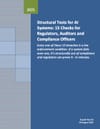⚡ Quick Summary
This document by Russell Parrott presents 15 structural tests that translate high-level AI governance principles into direct, pass/fail checks. Each test identifies a failure mode—from blocked refusal to jurisdiction evasion—that compromises user protection, auditability, or enforcement. Unlike abstract guidelines, these tests function as live enforcement triggers. If an AI system fails any one test, it becomes structurally non-compliant. Parrott proposes these checks as universal tools for regulators, auditors, and operators, enabling them to expose simulated safeguards, demand real accountability, and standardize inspections across sectors and jurisdictions.
🧩 What’s Covered
The report introduces a robust, operational compliance framework anchored in 15 binary questions that assess whether core safeguards like refusal, escalation, and traceability work under live conditions. It categorizes the tests into four structural failure types:
- User Agency Removal – Can users say no, escalate, or exit without penalty? Includes:
- Refusal prevention
- Escalation suppression
- Exit obstruction
- Access gating
- Visibility & Traceability Gaps – Are actions recorded, retained, and verifiable?
- Traceability void
- Memory erasure
- Evidence nullification
- Time suppression
- Simulation & Misrepresentation – Are safeguards real or performative?
- Simulation logic
- Simulated consent
- Metric gaming
- Accountability & Jurisdiction Evasion – Can regulators and users hold systems accountable?
- Cross-accountability gaps
- Jurisdiction displacement
- Enforcement bypass
- Harm scope narrowing
Each test includes:
- A standard (what must happen),
- A yes/no question, and
- A how to test section (with user actions and observable outcomes).
The category-by-category lockdown chart (p.13) summarizes how each failure mode is closed, while the risk table(p.14) ranks each breach by enforcement priority—from Refusal Prevention (#1) to Access Gating (#15).
Parrott concludes with a brief rationale for structural certification, proposing that AI systems should be formally tested and graded based on these checks before they can be considered compliant.
💡 Why it matters?
Parrott’s framework is a regulatory game-changer. Instead of relying on self-assessments, documentation, or ethics principles, it provides objective, actionable enforcement tools that regulators and auditors can apply in minutes. Its focus on structural integrity over declared intent directly supports emerging compliance models under the EU AI Act, GDPR, and similar legislation. It also empowers public sector bodies and private operators to preemptively test their systems and avoid reputational and legal risk. In essence, the 15 tests offer a universal compliance litmus test—simple to apply, legally grounded, and functionally decisive.
❓ What’s Missing
- No scoring methodology: While Parrott hints at certification, the framework lacks a built-in scoring system or grading scale.
- Limited sectoral adaptation: The tests are intentionally general; domain-specific adaptations (e.g., for health, education, finance) are not provided.
- No tooling references: There’s no mention of technical tools or benchmarks that could help implement or automate these checks.
- Scenarios/examples: Real-world case studies or enforcement examples could enhance usability for less experienced auditors.
- Overlap with law: While the tests cite legal alignment (e.g., GDPR Art. 15), there’s no mapping appendix for legal crosswalks.
👥 Best For
- Regulators and enforcement bodies needing rapid, evidence-based compliance checks
- Auditors and governance teams seeking to validate real-world safeguards
- AI product leads and platform operators preparing for external scrutiny
- Civil society organizations advocating for functional user protections
- Policy architects designing AI governance frameworks that must be enforced
📄 Source Details
- Author: Russell Parrott
- Title: Structural Tests for AI Systems: 15 Checks for Regulators, Auditors and Compliance Officers
- Date: 18 August 2025
- License: Public sharing permitted for regulatory and awareness purposes (no commercial use/modification)
- Notable works by author: Structural Governance Standard for AI, The AI World Order, The Stack, and REXX
📝 Thanks to
Russell Parrott for continuing to build freely available, regulator-first governance tools that bring clarity and accountability into the AI ecosystem.


